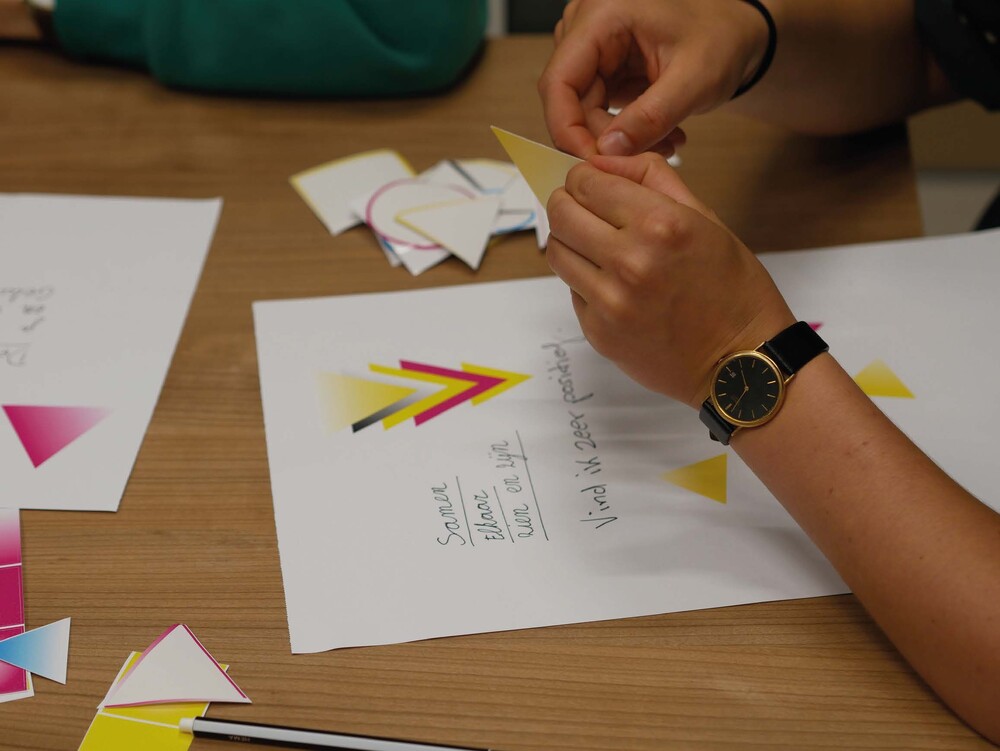
Mental Health For All
From March to June 2022, Design Academy Eindhoven (DAE) has deepened its partnership with mental healthcare institution GGzE De Grote Beek in Eindhoven with an extensive MA collaboration project, entitled Mental Health for All.
mental health problems can hinder our everyday lives. GGzE's mission is to help people with mental health problems in a way that suits their needs. This process, however, is complicated by obstacles at a regional and national level, such as growing waiting lists which mean that the institution does not always succeed in helping people at an early stage. It has also become difficult for GGzE to find staff for critical positions.
To address these and other challenges, GGzE invited the master's students at DAE to look at mental health issues from their design-oriented, critical and creative perspective. Students from all five master’s departments followed the institution's daily work with clients and employees and learned from their experiences, difficulties and ambitions. Working in multidisciplinary teams, the students collectively developed a series of social innovations, concepts or applications that could lead to a renewed understanding of mental health problems and care for people with related needs.
This MA project is part of the partnership with GGzE that began in 2021. The partnership encompasses the annual Planetree Design Award, lectures and excursions from GGzE by experts on mental health, and a yearly seminar on mental health during Dutch Design Week. The partnership’s main goal is to inspire students from DAE and to provide insights on social innovation to GGzE’s clients and experts, as well as sharing and exchanging knowledge on design and mental health.
“Your diversity, different backgrounds and endless creativity have surprised us and overwhelmed us a bit, but in a good way. We were impressed by your social engagement and the way you have initiated and participated in a real and necessary dialogue about mental health.”
“Our clients’ and employees’ stories are personal stories that can touch you and can resonate within yourself. That takes energy and guts. We also appreciate those students who dared to take a critical look at our work and the learning climate at the academy. This kind of honest reflection helps us to provide better care, and, I hope, it will help the school to provide better education.”
“Overall, we consider ourselves lucky to have a new generation of designers, encouraged by great tutors, who are facing a new world in which mental health is just as important as physical health.” Bas van Oosterhout, Director of Treatment
“Despite exhaustion, burnout and depression, and during one of the most severe crises experienced globally in recent history, the DAE students self-organised to carry out meaningful acts of solidarity and care within and beyond the academy. Their initiatives against overworking, precarity and discrimination in the design field and design education questioned how we live and the values we live by and had significant implications. The partnership with GGzE honoured and followed these efforts by putting mental health at the core of design practice.”
“We are grateful to GGzE for their invitation to the master's students at Design Academy Eindhoven to look at mental health issues from their design-oriented, critical and creative perspective. They have been the perfect project partners: open-minded, curious and supportive.”
“We are incredibly proud of all the students who, together with mentors and the GGzE community, reflected on the role of design in enabling and supporting well-being and developed proposals that might potentially change the world for the better.” Marina Otero, Head of Social Design
PROJECTS
→ Dolls Who Are Connected with Each Other By Inga Hamelmann, Siliang Li, Olga Korosteleva, Luzie Deubel and Marco Pagan in collaboration with Alice Bremmer, Inkeri Hyvarinen, Rob Lammers, Frans Lukassen and Marlies Verdonk

Just like spoken or written language, design and art can create communications tools in an attempt to make personal experiences tangible. They can help to make our inner (psychological) world understandable to us and those around us. The way that healing tools and environments have been designed often determines mental health clients’ interactions and experiences. To counter this, the students developed tools that could support clients in communicating their emotions or narrating their stories. Dolls Who Are Connected with Each Other is a series of collective poetry workshops designed to investigate how these semantics of mental health affected the interactions of people dealing with mental health problems.
→ The Second Skin By Filip Atanasov, Femke Hoppenbrouwer, Alice Moretto, Kasia Rachuba and Juyun Lee

The Second Skin focuses on the enormous number of products that claim to cure us of all kinds of mental illnesses or problems. When discussing this with the GGzE employees, the question “what helps?” was a decisive factor alongside “what does it cost?”. The MA students brought this together in an informative and beautiful visual way by making a catalogue with the information about the products organised on different levels and an accompanying projection of the objects on the human body. It is strong visual statement about how the medical industry plays on our fears (and profits from them).
→ Stories of Social Resonance By Dan Eames, Suzanne Corcessin, Flavie Liu, Jana Uhlig and Eric Treillard

The main objective of this project was to attempt to form a successful relationship with GGzE’s clients and staff. In this effort, the students took the specifics of GGzE and DAE as a starting point and tried to find out how these institutions could come together within this project. Not by designing for them, but by working with them. Individually, they joined workshops and explored the workspace, consequently developing design responses to their experiences. Their resulting stories were mapped onto a diagram based on Hartmut Rosa’s theory of social resonance, translated into a three-dimensional installation space.
→ Tours with Workers in GGzE By Theo Galliakis, Marco Loi, Camilla Marrese, Marta Oliveira Alves and Susanna Tomassini
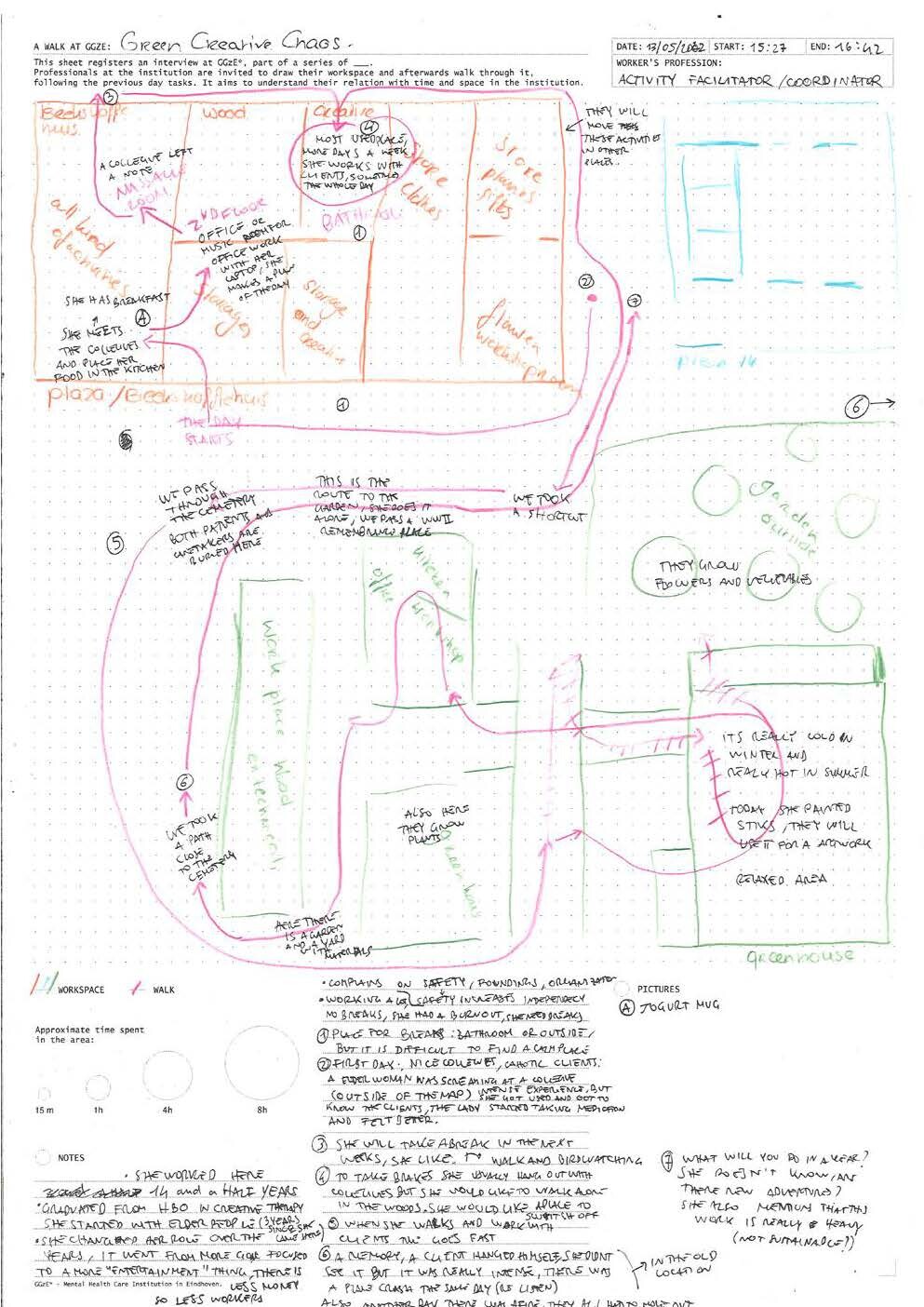
Tours were organised as a method to understand how workers at GGzE perceive the institution. The project focused especially on the workers’ perception of the time spent there, the way they appropriated the space, their relation with other workers and the clients. The method consisted of mapping their daily routine through a walk around the workplace, while interviewing them in an open conversation. The goal is to provide GGzE with a tool that helps to improve their connection with the workers.
→ Peer Support Workers By Marco Blazevic, Sigrid Schmeisser, Nicolas Neves, Guanyan Wu and Gal Yerushalmi in collaboration with Sissy van de Kerkhof, Inge van den Anker, Anne-Marie Walrecht-Kee, and Ivy Veira

Peer support workers are social workers who have lived experience of mental health challenges themselves. They use their experiences and empathy to support other people and their families during mental health recoveries. However, peer support workers are still stigmatised and receive less pay for doing the same amount of work as other healthcare workers at mental health organisations. The research project highlights the working conditions of peer support workers, how their work helps to support and inspire clients and examines how the value of peer support work can be better recognised.
Presented during the seminar Mental Health for All, organized by GGzE and DAE, on October 27, 2022
→ Time in It By Myrnade Bruijn, Emma Llorente Palacio, Linting Min, Léo Nunes Almeida and Jiayi Ye

Time in It is an exploratory workshop inspired by C.W. Leadbeater’s book The Astral Plane that attempts to transform the way time is perceived through engaging with non-human objects. The connection between humans and non-human objects could create a possibility for a different perception of time outside the division of the day in hours, minutes and seconds. . The students explored how time is perceived by non-humans and through interaction with non-humans. Affirming the existence of this subjective time within our body may be therapeutic in itself.
→ Defining the Essential By Yawen Cong, Louis Möckel, Lea Wurthmann and Tian Xia
Defining the Essential is the documentation of a series of experiments, interventions and interviews, in which the MA students tried to break down the importance, the meaning, and the essence of casual events and places using the example of a coffee break and the place this event usually takes place in. They searched for ways to deconstruct, to discuss, to define and to claim it back.
→ You Are How You Eat By Azusa Matsukubo, Daan Overgaag, Depali Pahwa and Ayoon Ro

The project You Are How You Eat invites people to take the time to enjoy a meal by themselves. In a world of constant distractions, it can be a challenge to take your time to eat, especially when you are alone, even though it is such an essential part of self-care. In a series of three podcasts, it invites listeners to embrace the idea of eating alone. The listeners are guided through the eating process, from preparation towards exploration with the aim of being grounded in the moment of eating and overcoming any discomfort that can be experienced when eating along.
→ Clay Convo By Soph Boobyer, Maria Gonçalves Camilo and Yasmin Knüsel
Clay convo is a group project, starting with a mutual interest in how care might inform design education itself at DAE. By using clay, the group found a disarmingly simple yet effective intervention to change the mode of conversation in the institution.
→ The Protocol of the Icebreaker By Teresa Carvalheira, Justine Charoy, Gabriele Nasole and Lucas Sabas Cid
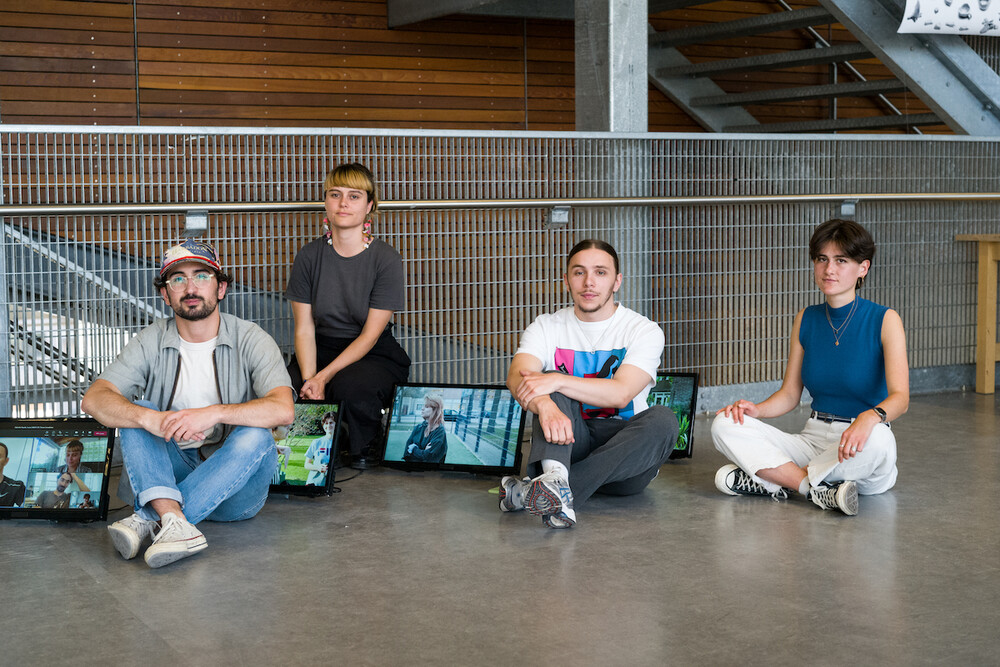
Our idea was to create a protocol that a group of four strangers could follow to gradually create a space within each other to bond, share and be vulnerable without feeling judged or misunderstood. We all took inspiration from our favourite activities and experimented with the protocol by doing each other’s favourite activities: football, crochet, boxing and cooking. We all figured that creating something like this could provide many benefits, such as reducing feelings of loneliness. Sharing could facilitate decompression, and even just having someone listen to us can sometimes be cathartic and freeing.
→ Queer Identities Through Algorithmic Taxonomy By Eva Bevec, Berta Grau Sánchez and Sara Levarato
This group coalesced around their shared interest in the proliferation of expressions of identity (gender, sexuality, etc.) on online platforms, especially YouTube. Their project comprised an edit of “coming out” videos from YouTube, exploring citation and repetition in the structure of this confessional medium, an almost script-like formal similarity in how “truths of the self” are expressed and indexed by young people online.
→ No Man is an Island By Fedora Boonaert and Clara Helbo
Between 1911 and 1961, approximately 700 men were housed on Livø, a Danish island located in the north of Jutland, in the Kellersk Institute, the Establishment for Inappropriate Men. The institute practice was to separate healthy individuals from the deviant in order to educate them. This division was based on the evaluation of the men's mental state and sexual behaviour. Anything that deviated from the heterosexual “norm” was considered
inappropriate and castration was used to prevent the residents from reproducing when they returned to the mainland.
→ Proximity By Yannis Mantzaris and Riccardo Petrini
Proximity is a visual enquiry about the notion of self-care in relation to the self and the other. Rendered in the form of a physical interactive atlas, its composition is the result of the querying process of JSTOR as it defines itself as the “world’s source of knowledge, cultures, and ideas”. Each degree of distance within the atlas represents the movement between individual and collective practices of self-care.
→ Is It Just Me? By Nils Axen, Anas Chao, Miguel Garchitorena and Maria Paloma Iriarte
Humans who act in the same way as others are considered normal. But what happens when there is an aberration among an entire group? How extreme must mass behaviour become in order for us to consider it psychologically abnormal? By exploring video examples of mass psychoses and aberrant group behaviour, the group researched and problematised the foundational basis of psychiatric theory in the individual subject.
→ Walking the Map By Chiyue Ding, Monika Gravagno, Rosa Raaphorst and Damir Zhaksilikov

Walking the Map is a project that reflects on the architecture, semiotics and wayfinding of the GGzE, and offers a new research methodology for navigating, exploring and interpreting the space. The students designed a series of workshops in which they invited GGzE’s clients to reflect on how they live, navigate the centre and create their maps and cartography of the GGzE.
→ Sense Your Body: A Non-Capitalist Self-Care’ By Giulia Braglia, Yujin Joung and Holly Zambonini
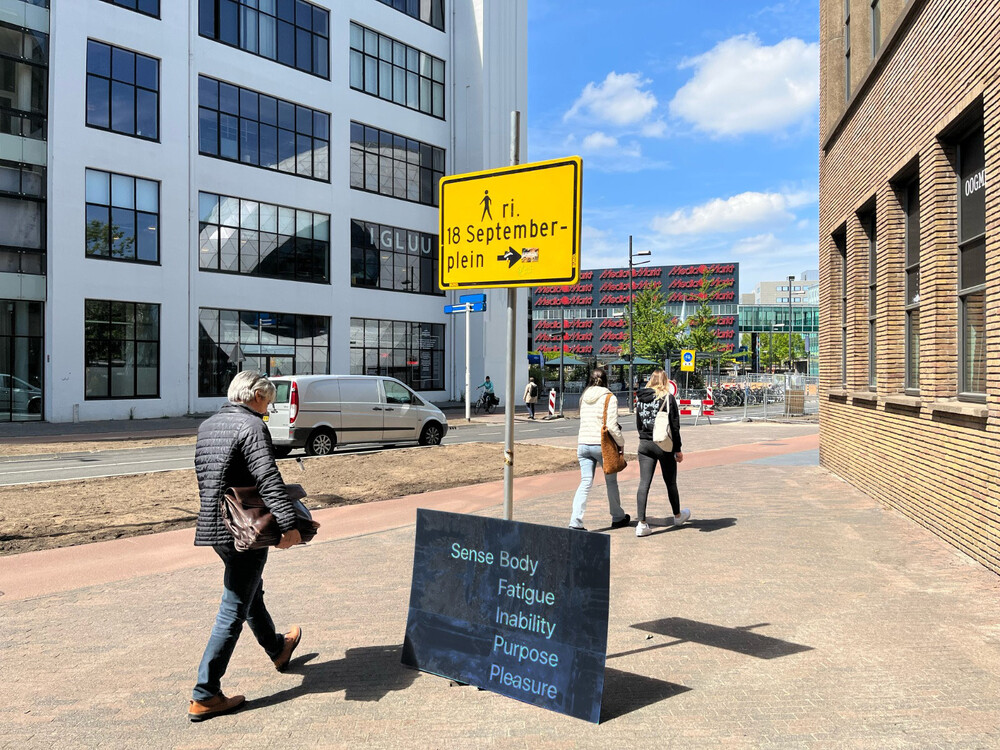
Sense Your Body: A Non-Capitalist Self-Care proposes the installation of LED signs with instructions for performative actions throughout the city of Eindhoven. These instructions reflect a new use of the LED sign as a capitalist symbol. The LED sign that uses the colour blue to call for feelings of calmness or serenity invites us to sense the stress and pressure in our bodies. By making mental health visible in the city’s public spaces, the signs signify the beginning of the removal of the boundary between the GGzE and the city and, in turn, the removal of the healthy/unhealthy binary.
→ Tiny Practices By Dace Burkevica, Ankit Kumar Singh and Guoda Šulskytė in collaboration with Anouk Bax, clients of GGzE the Boei, the Ukrainian Refugee Center in Eindhoven, and Mariam
Tiny Practices is a series of workshops in which the participants learned how to dye fabrics that can be brought back to life with a new level of beauty, incorporating and embracing the trauma they have personally gone through. Translating their stories onto fabrics using natural dyeing practices will form a rich narrative of resilience and growth. The workshops also focused on upcycling, mindfulness and ethical crafts using natural flora and fauna found in the GGzE grounds.
→ GGzE Tiny Houses By Daniel Garber, Amalia Magril and Yuanpu Wang in collaboration with Peter Klomp
Through ongoing conversations with Peter Klomp, GGzE’s garden manager, and using a site-specific material – loam –, the students created a manual for using soil in the tiny houses area on the GGzE estate to produce loam objects for the domestic space. Using the rammed-earth technique and layering of cut-wood shapes, GGzE’s clients can easily make their own customized and personalized objects.
"Getting dirty is important for connecting with nature, and benefits your mental state"
"If a 'client' is doing something that is appreciated by people from outside, it gives him confident and a feeling of accomplishment"
→ Rave By Marques Aroso Castro Marques, Tanay Kandpal and Gigi Totaro

This project builds on the idea of centred approaches by beginning from the group’s collective positive experiences of care during raves. The project contextualised itself in the DAE’s rave community for three months, from March to June 2022, aiming to understand the relationships between mental health and care in this community through in-situ methods of research that care for the community themselves. Organised in terms of before, during and after a rave, the project analysed the collected material through lenses of care, exploring relationships between care, mental health and raves.
→ Care & Hairdressers By Annebel Breij, Alexandra Ercoli Caller, Raphael Stodden and Laura Stachoń
Aware that accessing mental health care in the Netherlands is challenging, the group researched practices of non-institutionalised mental health care that exist in their communities. In their project, the students attempted to gain a better understanding of how hair salons in Eindhoven function as spaces for mental health care and investigated how these models and practices of care could be applied to other spaces. They researched the entanglement of material contexts, bodies, behaviours and relationships, objects and border social systems at play in hair salons and how these articulate and support mental health care practices within them.
Presented during the seminar Mental Health for All, organised by GGzE and DAE on 27 October 2022
→ Dined, Dine, Dining By Lucia Fabbri, Ji-Yun Lee and Nawon Koo

The focus of the group’s research was to gain a better understanding of the impact the DAE MA students’ end-term period has on their mental well-being and that of their community. In their research, they observed the students’ cooking and eating habits during this period. Inspired by this discovery, the students set themselves the goal to better understand the current mental health and dietary habits in their community and its interrelatedness, the practices of individual and collective care that students articulate around food and cooking and the structural conditions (spatial, economical, etc) that sustain such care.
→ Mental Stream By Shai Ben-Ami, Miguel Nunes Jorge Teodoro, Monika Litzinger, Monja Simon and Charles Weinberg
How do TV series influence our mental health? How does the act of watching a TV series turn into a shared care event? The project takes a further look at the content that we are
exposed to, the infrastructure put into place and the conditions under which TV series are consumed. The research analyses how the students portray, relate to, cope with and create a safe environment to address mental health, freeing it from stigmas.
→ Inconvenient Comfort By Matteo Bettini, Mirano Suzuki, Valentine Scherer and Guert-Yann Saint-André

Inconvenient Comfort points to a society that values constant progress and maximisation of efficiency. Various human activities have been automated and optimised in order to avoid the unexpectable. In a fast-paced reality, we tend to rush for goals and answers. Every step for achieving them is logicalised in order to reduce “wasteful” moments. We may have developed a fear of stagnation, thought loops and general malaise. What if we take our stuck moments as an opportunity to reconfigure and heal ourselves? The group believes that counterintuitive yet playful and low purpose choreographic scores can provide a new form of prevention and aftercare.
→ Student Union By Niels Nijman, Bhavneet Kaur, Antonia Wagner and Agatha Prieto Jeanty
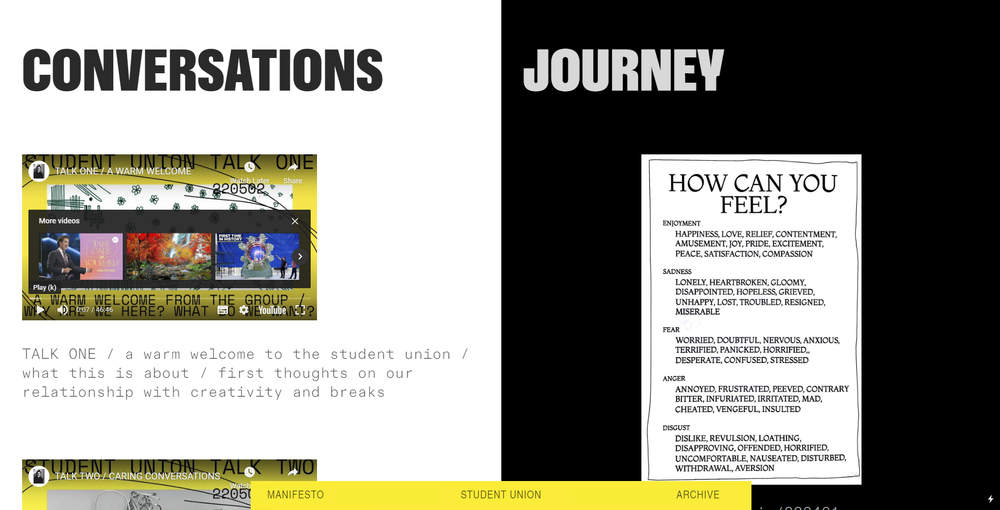
The students in this group focused on the desire to address the mental health support systems at DAE and form a ‘Living Utopia’ for self-care and healing their relationship with creativity. They designed a creative playground for collective care in the form of playful workshops and a conversational podcast series for talking about mental health for MA students at DAE.
→ Fit(T)iN’ REALitY By Rawan Khater, Rabia Sulhan and Freja Nielsen
Fit(T)iN’ REALitY aims to investigate parallels between edifying institutions. Edification means “improvement of the mind and understanding, especially by learning”, and is the core of many institutions, such as educational institutions, mental health institutions and prisons. The methodology of how to improve people’s minds and the perception of who is considered material for this transformation varies with the different types of institutions. However, one idea seems to be consistent: once you exit the institution, you should have become a better human. In response, one could ask: what is the intention of individual rather than collective edification? Who is the source and target in need of improvement? Who needs to change?
→ Materialising Metaphors By Augustina Lavickaitė Pyeori Jung, Barbara Vignaux and Ziyi Lian
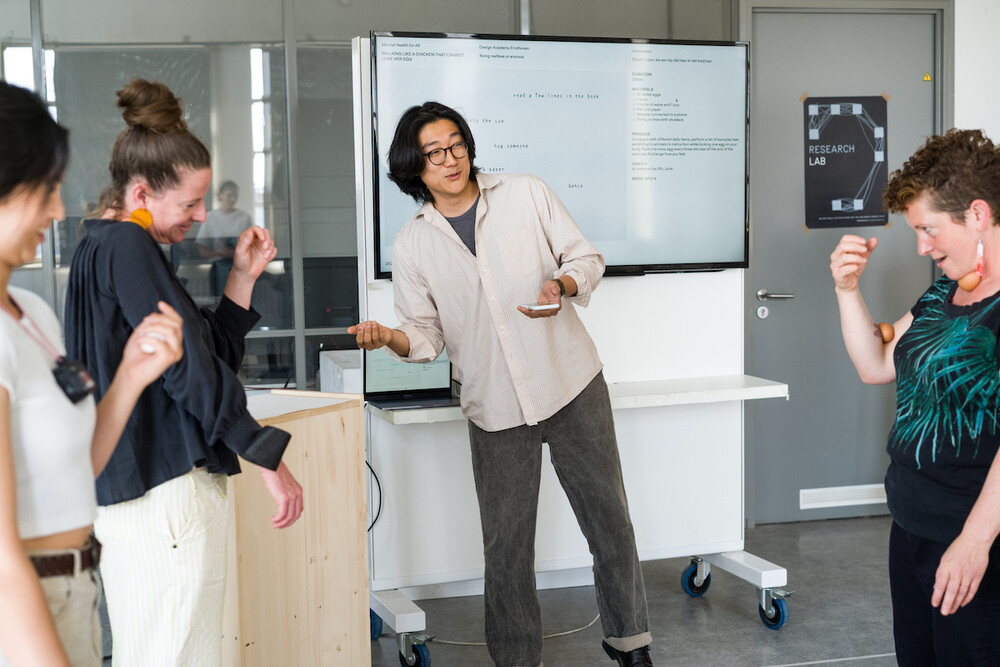
The group questioned the use of language in general and especially within GGzE (ex. DSM). Through workshops, they presented their research to raise awareness about and question how we use language regarding mental health. The way professionals use and curate diagnostic language as a medical method has an impact that extends beyond the mental health institution. It infiltrates our day-to-day conversations, shapes our subconscious and encourages categorisation. The MAstudents proposed a method to question why we use the language we use and ask what does it communicate to different people.
→ C.C.C. Cuisine By Martin Ayala Chavez, Pablo Bolumar Plata, Thijmen Peters, Walter Mingledorff III and Daniela Tokashiki Kunigami

For the research process, the group decided to focus on barbecues as a medium for enjoying the process of collective making and for maintaining their peace of mind during the project. They wanted to focus on creating a context that enables them to explore methods of collaborative care. The possibility of organising a barbecue, or the experience of organising it, invites the imagination. Organising barbecues allowed the students to enjoy working with their hands and focusing on the experience itself.
→ The Functioning Animal By Johanna Denecke, Rossy Liu and Ana Robles Perez

Humans have been using animals for mental health-related training for centuries. Animal-assisted therapy has been proven to have a positive effect. At GGzE, occupational therapy and equine therapy play a big role in creating meaningful experiences. If animals play such active roles in therapy for humans, what exactly are their conditions? Are we treating the animals with the same respect they expect for their own mental health issues? The aim of this research is to shift the perspective on animals away from a human-centric view by acknowledging their intrinsic value. The group proposed to learn from systems other than petting zoos in order to facilitate relationships between animals and clients.
→ Activating Boundaries By Jennifer Carniel, Ishani Chatterjee and Kaan Hiçyılmaz
The starting point of the research was the physical and psychological boundaries around the GGzE estate. The students started by researching the development of walls and fences and ultimately, their removal of the grounds. However, by methodically engaging with the staff, clients and other actors involved in the estate, the project became more of a guide to the issues at play in a site that is organised around mental health.
→ How to Move By Marie Kang and Hsiang-Lin Kuo
How to Move’ is a video with six tools that demonstrates how to ritualise daily movement into a bodywork routine. Inspired by the wide range of physical activities GGzE provided to mental health consumers, it goes without saying that there are many benefits for both the mind and body in movement. Both students were particularly interested in daily chores, such as gardening, cleaning or chopping wood. However, when performing daily chores, one often focuses on completing a task rather than being mindful of the body. Their ambition was to raise consciousness in unconscious daily movements and allow others to see their potential.
→ How to Eat an Apple at the Office By Yoojin Chung and Liping Hua
How to Eat an Apple at the Office is an allegory of the idea of interpassivity and the workplace as a space of experimentation. Interpassivity is the opposite of interactivity, describing a state of cognitive or emotional passivity, enabled or facilitated by the appearance or potential of interactivity. Taking the specific context of the Reddit thread “Can you eat snacks at your cubicle/office jobs?” the students considered the different ways of eating an apple as a symbol of hierarchy in the office. Workers are distracted by this “freedom” to eat an apple at their own will. This can be seen as a simple way to encourage a sense of care and belonging to the company, creating an underlying pressure of contribution, translating to a new mode of stress.
→ Nature Beyond Language By Szymon Klejborowski and Tino Yu

Traditional psychotherapy and most alternative therapies such as meditation and hypnosis are language-based. Language is the easiest communication tool but it also creates boundaries and stress in many situations. People have to keep thinking while they are listening or talking. In many situations, the words do not touch people’s hearts. The students want to let people take a break from using language, and just try to embrace the healing power of the natural ingredients. The healing exercises they designed are for anyone who would like to participate, they can be done anytime, and at many places within walking distance. No language is required during the sessions.
Presented during the seminar Mental Health for All, organised by GGzE and DAE on 27 October 2022. After the seminar, Tino continued working with GGzE on this project, which he further developed into his project Rain Watchers, an outdoor space for experiencing rain. You can read more about Rain Watchers here.